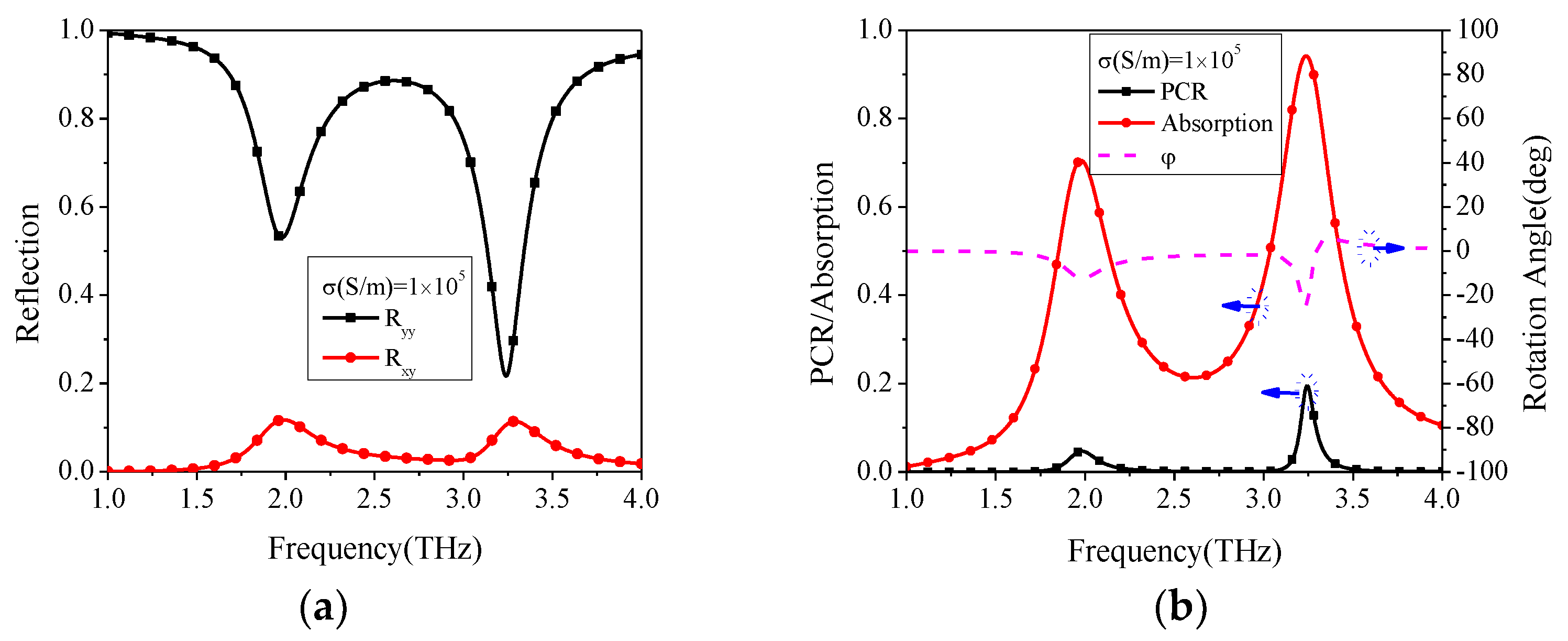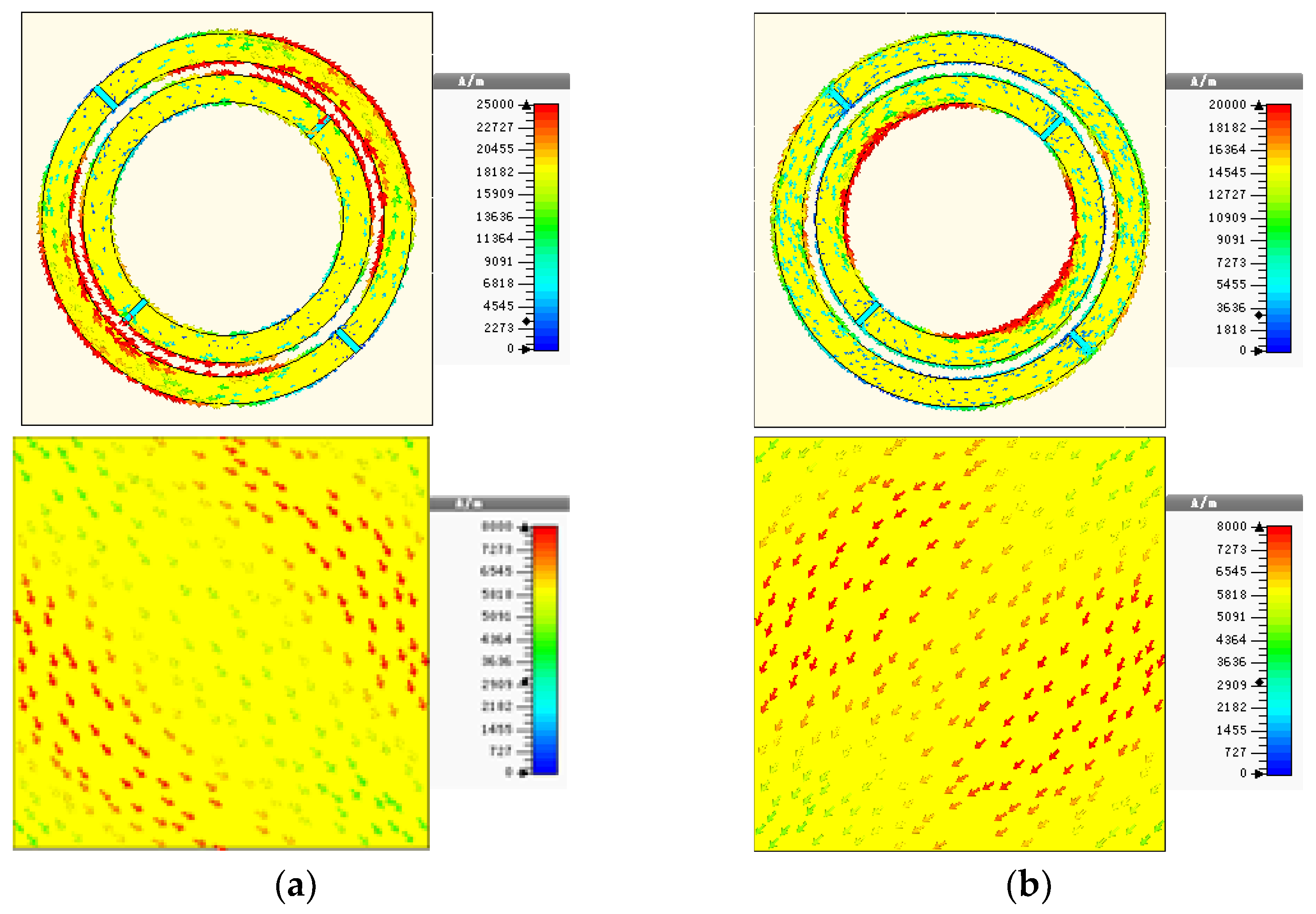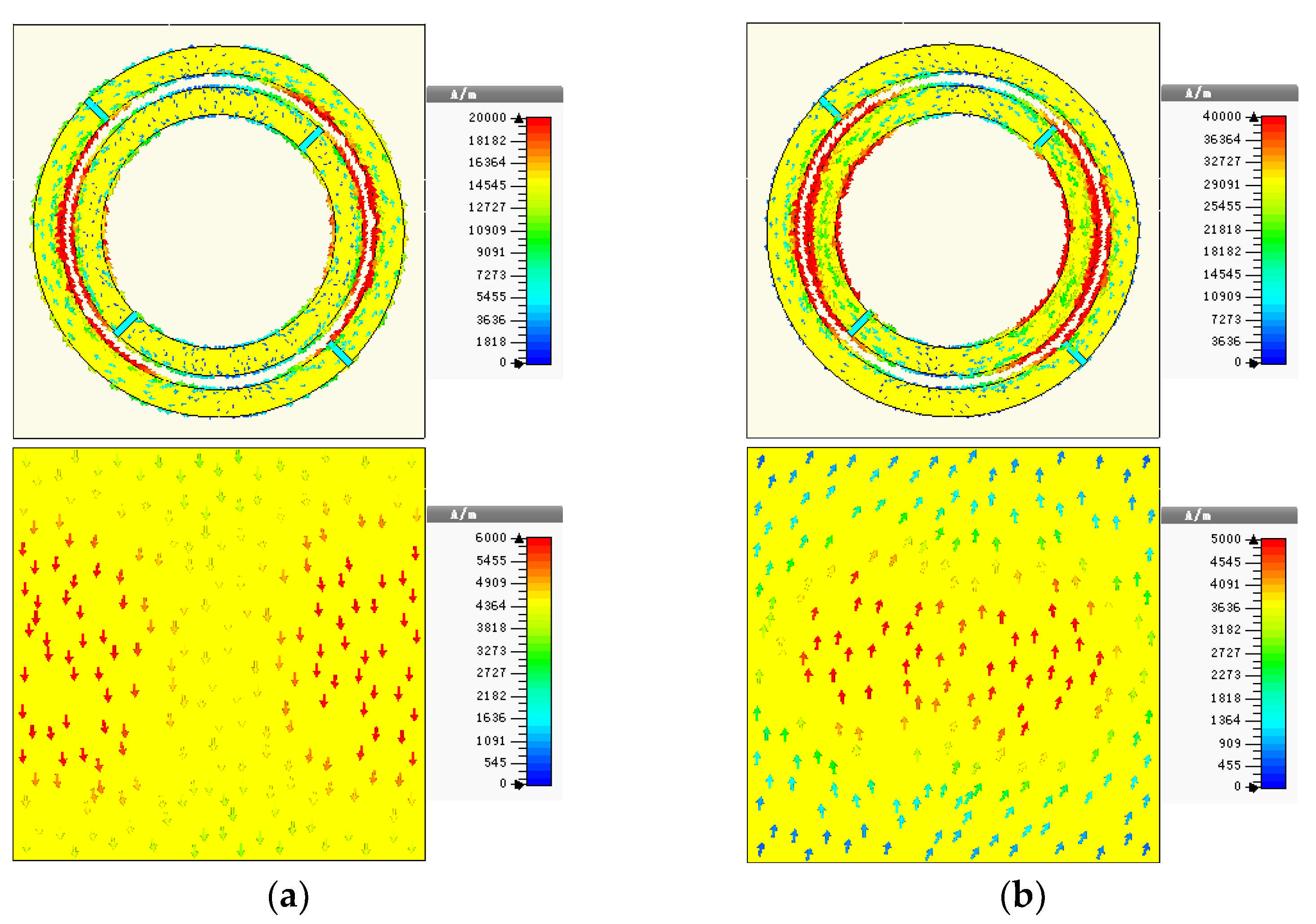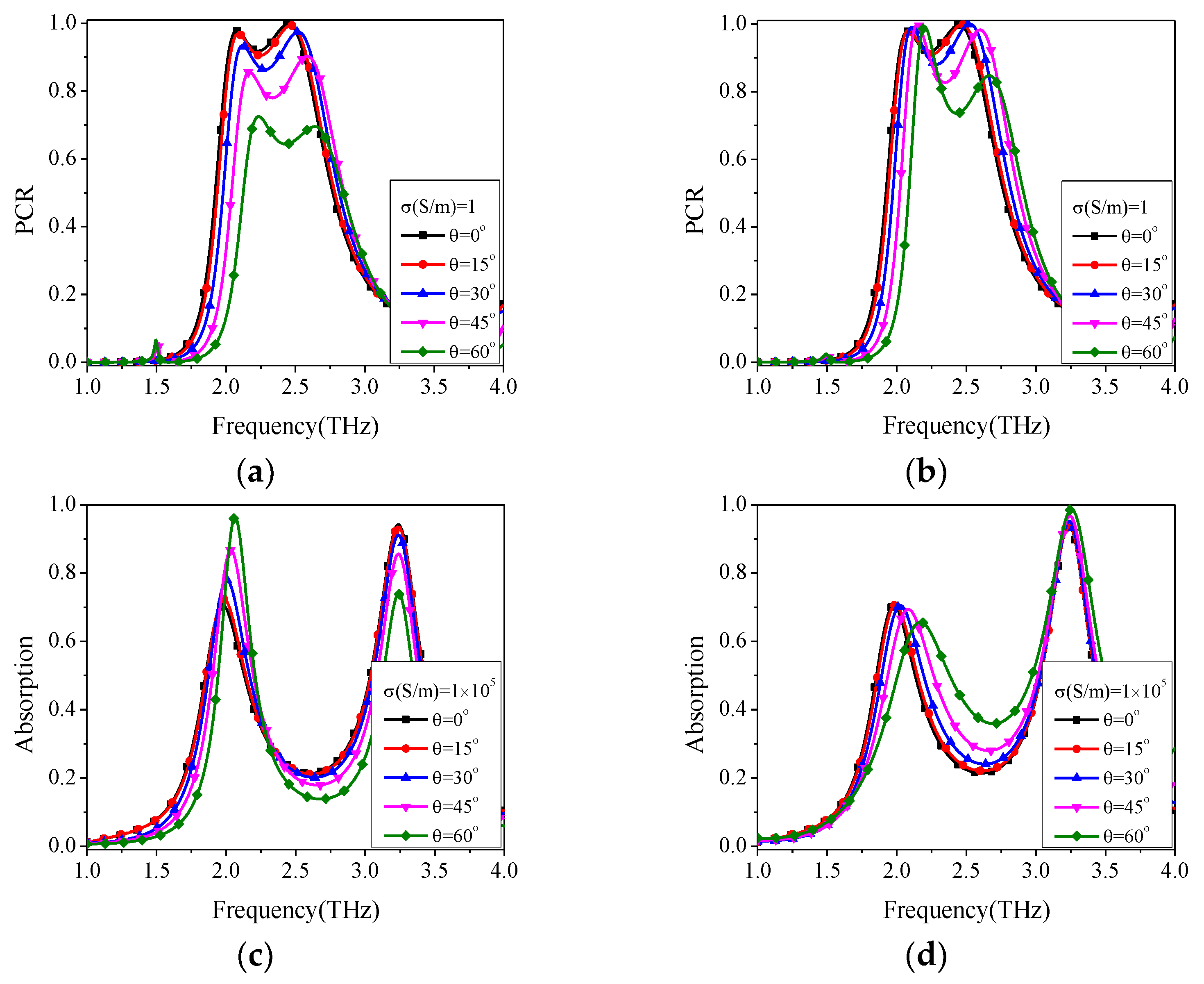Photo-Excited Switchable Terahertz Metamaterial Polarization Converter/Absorber
Abstract
:1. Introduction
2. Metamaterials and Methods
2.1. Metamaterials Model
2.2. Mathematical Method
3. Results and Discussions
3.1. Reflection Responses
3.2. Validation of the Equivalent Circuit Model
3.3. The Intrinsic Operation Mechanism
3.4. Oblique Incidence Characteristics
4. Conclusions
Author Contributions
Funding
Institutional Review Board Statement
Informed Consent Statement
Data Availability Statement
Acknowledgments
Conflicts of Interest
References
- Engheta, N. Metamaterials with high degrees of freedom: Space, time, and more. Nanophotonics 2020, 10, 639–642. [Google Scholar] [CrossRef]
- Xiao, S.; Wang, T.; Liu, T.; Zhou, C.; Jiang, X.; Zhang, J. Active metamaterials and metadevices: A review. J. Phys. D Appl. Phys. 2020, 53, 503002. [Google Scholar] [CrossRef]
- Deng, G.; Lv, K.; Sun, H.; Yang, J.; Yin, Z.; Li, Y.; Chi, B.; Li, X. An ultrathin, triple-band metamaterial absorber with wide-incident-angle stability for conformal applications at X and Ku frequency band. Nanoscale Res. Lett. 2020, 15, 217. [Google Scholar] [CrossRef] [PubMed]
- Yang, D.; Yin, Y.; Zhang, Z.; Li, D.; Cao, Y. Wide-angle microwave absorption properties of multilayer metamaterial fabricated by 3D printing. Mater. Lett. 2020, 281, 128571. [Google Scholar] [CrossRef]
- Li, H.; Ji, C.; Ren, Y.; Hu, J.; Qin, M.; Wang, L. Investigation of multiband plasmonic metamaterial perfect absorbers based on graphene ribbons by the phase-coupled method. Carbon 2019, 141, 481–487. [Google Scholar] [CrossRef]
- Al-Badri, K.S.L. Design of perfect metamaetiral absorber for microwave applications. Wirel. Pers. Commun. 2021, 1–8. [Google Scholar] [CrossRef]
- Wang, J.; Ding, X.; Huang, X.; Wu, J.; Li, Y.; Yang, H. Metamaterials absorber for multiple frequency points within 1 GHz. Phys. Scr. 2020, 95, 065505. [Google Scholar] [CrossRef]
- Zhou, B.C.; Wang, D.H.; Ma, J.J.; Li, B.Y.; Zhao, Y.J.; Li, K.X. An ultrathin and broadband radar absorber using metamaterials. Waves Random Complex Media 2021, 31, 911–920. [Google Scholar] [CrossRef]
- Magisetty, R.; Raj, A.B.; Datar, S.; Shukla, A.; Kandasubramanian, B. Nanocomposite engineered carbon fabric-mat as a passive metamaterial for stealth application. J. Alloys Compd. 2020, 848, 155771. [Google Scholar] [CrossRef]
- Li, W.; Zhang, Y.; Wu, T.; Cao, J.; Chen, Z.; Guan, J. Broadband radar cross section reduction by in-plane integration of scattering metasurfaces and magnetic absorbing materials. Results Phys. 2019, 12, 1964–1970. [Google Scholar] [CrossRef]
- Salami, P.; Yousefi, L. Wide-band polarisation-independent metasurface-based carpet cloak. IET Microw. Antennas Propag. 2020, 14, 1983–1989. [Google Scholar] [CrossRef]
- Yang, J.; Huang, C.; Wu, X.; Sun, B.; Luo, X. Dual-wavelength carpet cloak using ultrathin metasurface. Adv. Opt. Mater. 2018, 6, 1800073. [Google Scholar] [CrossRef]
- Lin, M.; Xu, M.; Wan, X.; Liu, H.; Wu, Z.; Liu, J.; Deng, B.; Guan, D.; Zha, S. Single sensor to estimate DOA with programmable metasurface. IEEE Internet Things J. 2021, 8, 10187–10197. [Google Scholar] [CrossRef]
- Cai, J.; Zhou, Y.J.; Yang, X.M. A metamaterials-loaded quarter mode SIW microfluidic sensor for microliter liquid characterization. J. Electromagn. Waves Appl. 2019, 33, 261–271. [Google Scholar] [CrossRef]
- Ming-zhen, X.; Yang, Z.; Wei-ling, F.; Jin-chun, H. Microfludic refractive index sensor based on terahertz metamaterials. Spectrosc. Spectr. Anal. 2021, 41, 1039–1043. [Google Scholar]
- Zhang, Y.; Tian, Y.; Zhang, Y.; Dai, L.; Liu, S.; Zhang, Y.; Zhang, H. Dual-function polarizer based on hybrid metasurfaces of vanadium dioxide and Dirac semimetals. Opt. Commun. 2020, 477, 126348. [Google Scholar] [CrossRef]
- da Silva Paiva, J.L.; da Silva, J.P.; Campos, A.L.P.D.S.; de Andrade, H.D. Using metasurface structures as signal polarisers in microstrip antennas. IET Microw. Antennas Propag. 2019, 13, 23–27. [Google Scholar] [CrossRef]
- Yao, Z.; Lu, M.; Zhang, C.; Wang, Y. Dynamically tunable and transmissive linear to circular polarizer based on graphene metasurfaces. JOSA B 2019, 36, 3302–3306. [Google Scholar] [CrossRef]
- Khan, S.; Eibert, T.F. A dual-band metasheet for asymmetric microwave transmission with polarization conversion. IEEE Access 2019, 7, 98045–98052. [Google Scholar] [CrossRef]
- Zhong, R.; Yang, L.; Liang, Z.; Wu, Z.; Wang, Y.; Ma, A.; Fang, Z.; Liu, S. Ultrawideband terahertz absorber with a graphene-loaded dielectric hemi-ellipsoid. Opt. Express 2020, 28, 28773–28781. [Google Scholar] [CrossRef]
- Dong, Y.; Yu, D.; Li, G.; Li, G.; Ma, H. Tunable ultrathin ultrabroadband metamaterial absorber with graphene-stack-based structure at lower terahertz frequency. Phys. E Low-Dimens. Syst. Nanostruct. 2021, 128, 114608. [Google Scholar] [CrossRef]
- Liu, H.B.; Hu, C.X.; Wang, Z.L.; Zhang, H.F.; Li, H.M. An ultra-wideband terahertz metamaterial absorber based on the fractal structure. Plasmonics 2020, 16, 263–271. [Google Scholar] [CrossRef]
- Zhang, J.; Li, Z.; Shao, L.; Zhu, W. Dynamical absorption manipulation in a graphene-based optically transparent and flexible metasurface. Carbon 2021, 176, 374–382. [Google Scholar] [CrossRef]
- Chu, H.; Qi, J.; Xiao, S.; Qiu, J. A thin wideband high-spatial-resolution focusing metasurface for near-field passive millimeter-wave imaging. Appl. Phys. Lett. 2018, 112, 174101. [Google Scholar] [CrossRef]
- Zhu, W.M.; Cai, H.; Mei, T.; Bourouina, T.; Tao, J.F.; Lo, G.Q.; Kwong, D.L.; Liu, A.Q. A MEMS tunable metamaterial filter. In Proceedings of the 2010 IEEE 23rd International Conference on Micro Electro Mechanical Systems (MEMS), Hong Kong, China, 24–28 January 2010; Volume 33, pp. 196–199. [Google Scholar]
- Ma, F.; Lin, Y.S.; Zhang, X.; Lee, C. Tunable multiband terahertz metamaterials using a reconfigurable electric split-ring resonator array. Light Sci. Appl. 2014, 3, e171. [Google Scholar] [CrossRef] [Green Version]
- Kliros, G.S.; Venetis, D.E. Design of a tunable dual-band THz absorber based on metamaterial split-ring resonators coupled to grapheme. In Proceedings of the 2016 IEEE International Semiconductor Conference (CAS), Sinaia, Romania, 10–12 October 2016; pp. 41–44. [Google Scholar]
- Liu, C.; Bai, Y.; Ma, X. Design of a tunable dual-band terahertz absorber based on graphene metamaterial. Opt. Eng. 2018, 57, 117105. [Google Scholar] [CrossRef]
- Ahmadivand, A.; Gerislioglu, B.; Ramezani, Z. Gated graphene island-enabled tunable charge transfer plasmon terahertz metamodulator. Nanoscale 2019, 11, 8091–8095. [Google Scholar] [CrossRef] [PubMed]
- Zhao, Y.; Huang, Q.; Cai, H.; Lin, X.; Lu, Y. A broadband and switchable VO2-based perfect absorber at the THz frequency. Opt. Commun. 2018, 426, 443–449. [Google Scholar]
- Wang, S.; Cai, C.; You, M.; Liu, F.; Wu, M.; Li, S.; Bao, H.; Kang, L.; Werner, D.H. Vanadium dioxide based broadband THz metamaterial absorbers with high tunability: Simulation study. Opt. Express 2019, 27, 19436–19447. [Google Scholar] [CrossRef]
- Zou, H.; Cheng, Y. Design of a six-band terahertz metamaterial absorber for temperature sensing application. Opt. Mater. 2019, 88, 674–679. [Google Scholar] [CrossRef]
- Liu, H.; Ren, G.; Gao, Y.; Zhu, B.; Wu, B.; Li, H.; Jian, S. Tunable terahertz plasmonic perfect absorber based on T-shaped InSb array. Plasmonics 2016, 11, 411–417. [Google Scholar] [CrossRef]
- Agarwal, P.; Medwal, R.; Kumar, A.; Asada, H.; Fukuma, Y.; Rawat, R.S.; Battiato, M.; Singh, R. Ultrafast photo-thermal switching of terahertz spin currents. Adv. Funct. Mater. 2021, 31, 2010453. [Google Scholar] [CrossRef]
- Zhao, J.; Cheng, Y.; Cheng, Z. Design of a photo-excited switchable broadband reflective linear polarization conversion metasurface for terahertz waves. IEEE Photon. J. 2018, 10, 4600210. [Google Scholar] [CrossRef]
- Xu, Z.C.; Wu, L.; Zhang, Y.T.; Xu, D.G.; Yao, J.Q. Photoexcited blueshift and redshift switchable metamaterial absorber at terahertz frequencies. Chin. Phys. Lett. 2019, 36, 124202. [Google Scholar] [CrossRef]
- Lang, T.; Shen, T.; Wang, G.; Shen, C. Tunable broadband all-silicon terahertz absorber based on a simple metamaterial structure. Appl. Opt. 2020, 59, 6265–6270. [Google Scholar] [CrossRef] [PubMed]
- Bing, P.; Guo, X.; Wang, H.; Li, Z.; Yao, J. Characteristic analysis of a photoexcited tunable metamaterial absorber for terahertz waves. J. Opt. 2019, 48, 179–183. [Google Scholar] [CrossRef]
- Song, Z.; Wang, Z.; Wei, M. Broadband tunable absorber for terahertz waves based on isotropic silicon metasurfaces. Mater. Lett. 2019, 234, 138–141. [Google Scholar] [CrossRef]
- Zhao, X.; Wang, Y.; Schalch, J.; Duan, G.; Cremin, K.; Zhang, J.; Chen, C.; Averitt, R.D.; Zhang, X. Optically modulated ultra-broadband all silicon metamaterial terahertz absorbers. ACS Photon. 2019, 6, 830–837. [Google Scholar] [CrossRef]
- You, X.; Upadhyay, A.; Cheng, Y.; Bhaskaran, M.; Sriram, S.; Fumeaux, C.; Withayachumnankul, W. Ultra-wideband far-infrared absorber based on anisotropically etched doped silicon. Opt. Lett. 2020, 45, 1196–1199. [Google Scholar] [CrossRef]
- Cheng, Y.; Liu, J.; Chen, F.; Luo, H.; Li, X. Optically switchable broadband metasurface absorber based on square ring shaped photoconductive silicon for terahertz waves. Phys. Lett. A 2021, 402, 127345. [Google Scholar] [CrossRef]
- Wu, J. A polarization insensitive dual-band tunable graphene absorber at the THz frequency. Phys. Lett. A 2020, 384, 126890. [Google Scholar] [CrossRef]
- Cheng, Z.; Cheng, Y. A multi-functional polarization convertor based on chiral metamaterial for terahertz waves. Opt. Commun. 2019, 435, 178–182. [Google Scholar] [CrossRef]
- Wong, H.; Wang, K.X.; Huitema, L.; Crunteanu, A. Active meta polarizer for terahertz frequencies. Sci. Rep. 2020, 10, 15382. [Google Scholar] [CrossRef]
- Sasaki, T.; Nishie, Y.; Kambayashi, M.; Sakamoto, M.; Noda, K.; Okamoto, H.; Kawatsuki, N.; Ono, H. Active terahertz polarization converter using a liquid crystal-embedded metal mesh. IEEE Photon. J. 2019, 11, 1–7. [Google Scholar] [CrossRef]
- Liu, X.; Liu, H.; Sun, Q.; Huang, N. Metamaterial terahertz switch based on split-ring resonator embedded with photoconductive silicon. Appl. Opt. 2015, 54, 3478–3483. [Google Scholar] [CrossRef]
- Ding, J.; Arigong, B.; Ren, H.; Zhou, M.; Shao, J.; Lin, Y.; Zhang, H. Efficient multiband and broadband cross polarization converters based on slotted L-shaped nanoantennas. Opt. Express 2014, 22, 29143–29151. [Google Scholar] [CrossRef] [PubMed]
- Tang, S.C.; Yu, C.H.; Chiou, Y.C.; Kuo, J.T. Extraction of electric and magnetic coupling for coupled symmetric microstrip resonator bandpass filter with tunable transmission zero. In Proceedings of the 2009 Asia Pacific Microwave Conference, Singapore, 7–10 December 2009; pp. 2064–2067. [Google Scholar]
- Al-Behadili, A.A.; Mocanu, I.A.; Codreanu, N.; Pantazica, M. Modified split ring resonators sensor for accurate complex permittivity measurements of solid dielectrics. Sensors 2020, 20, 6855. [Google Scholar] [CrossRef] [PubMed]
- Sheikh, S. Miniaturized-element frequency-selective surfaces based on the transparent element to a specific polarization. IEEE Antennas Wirel. Propag. Lett. 2016, 15, 1661–1664. [Google Scholar] [CrossRef]








Publisher’s Note: MDPI stays neutral with regard to jurisdictional claims in published maps and institutional affiliations. |
© 2021 by the authors. Licensee MDPI, Basel, Switzerland. This article is an open access article distributed under the terms and conditions of the Creative Commons Attribution (CC BY) license (https://creativecommons.org/licenses/by/4.0/).
Share and Cite
Yu, D.; Dong, Y.; Ruan, Y.; Li, G.; Li, G.; Ma, H.; Deng, S.; Liu, Z. Photo-Excited Switchable Terahertz Metamaterial Polarization Converter/Absorber. Crystals 2021, 11, 1116. https://doi.org/10.3390/cryst11091116
Yu D, Dong Y, Ruan Y, Li G, Li G, Ma H, Deng S, Liu Z. Photo-Excited Switchable Terahertz Metamaterial Polarization Converter/Absorber. Crystals. 2021; 11(9):1116. https://doi.org/10.3390/cryst11091116
Chicago/Turabian StyleYu, Dingwang, Yanfei Dong, Youde Ruan, Guochao Li, Gaosheng Li, Haomin Ma, Song Deng, and Zhenpeng Liu. 2021. "Photo-Excited Switchable Terahertz Metamaterial Polarization Converter/Absorber" Crystals 11, no. 9: 1116. https://doi.org/10.3390/cryst11091116
APA StyleYu, D., Dong, Y., Ruan, Y., Li, G., Li, G., Ma, H., Deng, S., & Liu, Z. (2021). Photo-Excited Switchable Terahertz Metamaterial Polarization Converter/Absorber. Crystals, 11(9), 1116. https://doi.org/10.3390/cryst11091116





